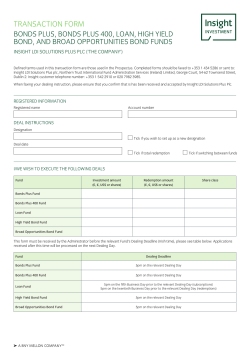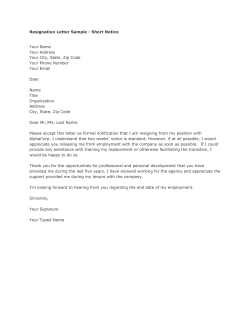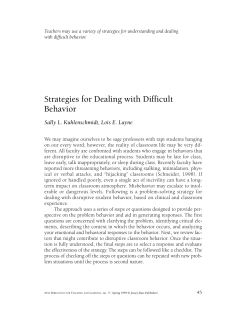
Dealing with Difficult People effort, you can be impossible!
Dealing with Difficult People Why Be difficult when with just a little bit of effort, you can be impossible! Conflict • Conflict is inevitable in the workplace. However, that does not mean that we cannot work to prevent unproductive behavior that leads to conflict. Difficult behavior is a good example of an area where a difference can be made. Although it is easy to label people as difficult, the real focus should always be on the actual behavior. Dealing effectively with difficult behavior is a skill that can nip conflict in the bud. Difficult Behavior • Difficult behavior takes many forms. It includes gossiping, going over your bosses head, foot dragging, ignoring orders, refusing to talk, being rude, yelling, ignoring, harassing, and much more. Difficult Behavior • At the core, most conflict is about needs that have not been satisfied-not just physical needs, but also psychological and procedural needs. Difficult behavior is often a result of psychological needs for control, recognition, affection, and respect. How to Deal with the Behavior 1. Stay centered • When we loose our self-control and restraint the situation does not improve. In fact it is more likely to get worse. Decisions made in the heat of the moment are seldom the best, and lack the benefits of our creativity. Our challenge is to slow down, and resist a knee jerk reaction. Staying steady, stable and grounded gives us the strong foundation we need to take on the most difficult behavior. • When we indulge ourselves by taking it personally (forgetting that offense is 10% given and 90% taken) we start playing negative internal tapes in our head. We tell ourselves that the person is bad, unreliable, beyond reason. The danger is that these labels become self-fulfilling, and do not give any benefit of the doubt. Rather than putting our energy into problem solving we feel smug blaming the other. We forget that it takes two to make things worse. How to Deal with the Behavior 2. Reality check • An important question to consider as soon as possible is whether the behavior is really causing performance problems. If it is not, and left alone things will not get worse, then leaving things often makes sense. As we reality check, it is important to consider the impact of the behavior on others and not just ourselves. How to Deal with the Behavior 3. Focus on behavior • This is the key to dealing with difficult behavior. As tempting as it is to focus on the person this should be avoided. By separating the person from the behavior it enables one-to paraphrase Fisher, Ury and Patton in their best seller “Getting to Yes” -to be hard on the problem and soft on the person. How to Deal with the Behavior 4. Listen • Listening is widely acknowledged as a core communication skill that affects the ways we prevent and resolve conflict. When dealing with people whose behavior is getting to us we should make a special effort to hear the other person out. Even when you disagree! This enables you to validate the psychological needs of the other, and to let them know that you can imagine how they are feeling. How to Deal with the Behavior 5. Give feedback • A common problem with difficult behavior is that the person is unaware that his or her behavior is causing a problem. At other times the extent of the impact is not comprehended. By giving timely feedback about specific behavior misunderstanding can be avoided and expectations clarified. A useful formula for giving feedback that deals with both emotions and facts, is the “I-Statement.” I feel frustrated when you interrupt me at our team meetings. It breaks my train of thought and I struggle getting started again. I would appreciate it if I could finish with what I am saying.” Three Choices to Deal with Difficult Managers and Co-workers • Confront the Difficult Person • Cope with the Difficult Person • Get Away (Leave) from the Difficult Person Coping with Difficult Situations • Assess the Situation- Am I dealing with a difficult person or a difficult situation? • What am I willing to accept about this person or situation? • Should I put some distance between me and the person or situation? Strategy to Cope with All Types • Major Strategy- Bring Issues and Problems Out in the Open. • Do not Believe that Ignoring these Issues and Problems will make them go away. • Recognize the Difference Between a Difficult Person and a Difficult Work Situation • Find an Anchor for Your Own Sanity • The reality is that we can all be difficult from time to time. Dealing with difficult behavior is not easy and so we often procrastinate. We do so at our own peril. Being proactive and engaging the person in a conversation about their behavior is the first step toward conflict prevention. Exercise 1.List one behavior that you find difficult to manage 2.What is the result of managing the behavior? 3.How does the difficult behavior impact your ability to manage? Re: Understanding Difficult Behavior *Adapted from U.S. Institute of Peace Resources 10 Classic Problem Types 1. 2. 3. 4. 5. The Tank The Sniper The Grenade The Know-It-All The Think-TheyKnow-It- All 6. The Yes Person 7. The Maybe Person 8. The Nothing Person 9. The No Person 10. The Whiner Adapted from Dealing With People You Can’t Stand, Dr. Rick Brinkman & Dr. Rick Kirschner Dealing with the “Tank” “TANK” CHARACTERISTICS: • Wants to control the process and get things done • Behavior ranges from mild pushiness to outright aggression CHALLENGES: • Commanding respect • Holding your ground • Interrupting the attack • Aiming for the bottom line and fire • Establishing peace with honor (Such as: “You and I have to work together”) Dealing with the “Sniper” “SNIPER” CHARACTERISTICS: • Attempts to control you through embarrassment and humiliation CHALLENGES: • Bringing the sniper out of hiding • Using searchlight questions like: “What’s the intent or relevancy of that statement?” • Using “Tank” behaviors if necessary • Making the behavior of “Sniping” uncomfortable Dealing with “Grenades” “GRENADES” CHARACTERISTICS: • Feels unappreciated and disrespected • Ranting and raving is difficult to ignore CHALLENGES: • • • • • Taking control of the situation Getting their attention Making sure your tone and language are friendly Showing genuine concern Reducing intensity Dealing with the “Know-it-All” “KNOW-IT-ALL” CHARACTERISTICS: • Knowledgeable and competent people who intend to get it done in the way they have predetermined is best. CHALLENGES: • • • • • • Opening them up to new ideas Being prepared and knowing your stuff Blending with their doubts and desires Presenting your views indirectly Turning them into mentors Recognizing their expertise Dealing with “Think-They-Know-It Alls” “THINK-THEY-KNOW-IT-ALL” CHARACTERISTICS: • Specialists in exaggeration, half-truths, jargon, useless advice, and unsolicited opinions • Charismatic and desperate for attention CHALLENGES: • • • • • • Finding an acceptable way to disavow their unworkable ideas Providing them a little attention Getting clarification for specifics Being patient Gently confronting them with the consequences of their negative behavior Crediting the things they do right Dealing with the “Yes” Person “YES” CHARACTERISTICS: • • Gets along but can easily over commit Doesn’t understand the true nature of the task they have accepted. CHALLENGES: • • • • • • • Getting commitments you can count on Making it safe to be honest Talking openly and acknowledging their honesty Helping them learn to better plan Getting their word and summarizing their commitment Ensuring understanding of negative consequences Strengthening the relationship Dealing with the “Maybe” Person “MAYBE” CHARACTERISTICS: • The downside of each option blinds them CHALLENGES: • • • • • • Helping them to think decisively Establishing and maintaining a comfort zone Surfacing conflicts and clarifying issues Using a decision-making system Reassuring and then ensuring follow through Strengthening the relationship Dealing with the “Nothing” Person “NOTHING” CHARACTERISTICS: • • • • Passive Can be task focused or people focused Tends to be a perfectionist when task-oriented Tends to withdraw when people-oriented (rather than hurting anyone’s feelings) CHALLENGES: • Persuading them to talk • Planning enough time • Asking open-ended questions • Lightening the mood Dealing with the “No” Person “NO” CHARACTERISTICS: • Task-focused and needs to get it right • Finds the negatives in everyone and everything CHALLENGES: • • • • • Moving from fault finding to problem solving Allowing them to be negative Using them as a resource and early warning system Not pushing for an immediate decision Acknowledging their good intent Dealing with the “Whiner” “WHINER” CHARACTERISTICS: • Suffers from severe inability to see what could and should be • Sees things wrong with what was and with what is. CHALLENGES: • Forming a problem-solving alliance • Listening for the main points • Getting specific • Shifting the focus to solutions • Showing them the future • Drawing the line - talk solutions or stop talking for now Essential Skills for dealing with difficult problems and/or behaviors… • Blending (Finding the person’s “Frame of Reference”) – Any behavior by which you reduce the differences between you and another in order to meet them where they are and move to a common ground • Redirecting (Creating a “Mind Shift”) – Any behavior by which you use the rapport gained by blending to change the direction of an interaction. Blending precedes redirecting, whether you’re listening to understand or speaking to be understood. Blending… • Blend with body and facial expressions • Blend vocally with volume and speed • Listen to understand (Chinese verb “To listen”) – – – – – Blend Backtrack Clarify Summarize what you’ve heard Confirm to make sure you got it right Reaching a Deeper Understanding… • Identify positive intent – “Positive intent” is the good purpose meant to be served by a given communication or behavior – Apply “Positive Intent” to… • Getting the job done • Getting the job done right • Getting along with others • Getting appreciation Speaking to be understood… • • • • Monitor your tone of voice State your positive intent Tactfully control interruptions Tell your truth – – – – Use “I” language Be specific about the problem behavior Help them understand how their behavior is self defeating Suggest new behaviors or options • Stay flexible “The wise person seeks first to understand and then be understood.” Getting What You Project and Expect… • Raise your expectations of people to help them raise their expectations of themselves. • Appreciate the person. • Be stern on bad behavior. • Expect good behavior. • Assume the best and give the benefit of the doubt. • Appreciate constructive criticism. – Don’t be defensive. – Verbally appreciate the person providing the criticism. – Redirect if necessary - focus on activities, not persons. How to Deal With The Emotions • Can you recall the last time you had to deal with a negative or difficult person? Or the last time someone said something with the intention of hurting you? How did you handle it? What was the result? What can you do in the future to get through these situations with peace and grace? How To Deal With The Emotions • No matter where we go, we will face people who are negative, people who oppose our ideas, people who piss us off or people who simply do not like us. • This fact isn’t the cause of conflict but it is the trigger to our emotions and our emotions are what drive us back to our most basic survival instinct; react and attack back to defend ourselves. How To Deal With The Emotions • In these instinctual moments, we may lose track of our higher selves and become the human animal with an urge to protect ourselves when attacked. This too is natural. However, we are the only animal blessed with intelligence and having the ability to control our responses. So how can we do that? Why Bother Controlling Our Responses? 1. Hurting Ourselves “Holding a grudge against someone is like drinking poison and expecting the other person to die.” The only person we hurt is ourselves. When we react to negativity, we are disturbing our inner space and mentally creating pain within ourselves. 2. It’s Not About You, It’s About Them • when people initiate negativity, it is a reflection of their inner state expressed externally and you just happen to be in front of that expression. It’s not personal, so why do we take it personally? In short: Because our ego likes problems and conflict 3. Battle of the Ego • When we respond impulsively, it is a natural and honest response. However, is it the smart thing to do? What can be resolved by doing so? The answer: Nothing. It does however feed our ego’s need for conflict. 4. Anger Feeds Anger. Negativity Feeds Negativity. • Rarely can any good come out of reacting against someone who is in a negative state. It will only trigger anger and an additional reactive response from that person. If we do respond impulsively, we’ll have invested energy in the defending of ourselves and we’ll feel more psychologically compelled to defend ourselves going forward. 5. Waste of Energy • Where attention goes, energy flows. What we focus on tends to expand itself. Since we can only focus on one thing at a time, energy spent on negativity is energy that could have been spent on our personal wellbeing. 6. Negativity Spreads • When we are in a negative state or holding a grudge against someone, we don’t feel very good. We carry that energy with us as we go about our day. When we don’t feel very good, we lose sight of clarity and may react unconsciously to matters in other areas of our lives, unnecessarily. 7. Freedom of Speech • People are as entitled to their opinions as you are. Allow them to express how they feel and let it be. Remember that it’s all relative and a matter of perspective. What we consider positive can be perceived by another as negative. • Some people may have a less than eloquent way of expressing themselves – it may even be offensive, but they are still entitled to do so. They have the right to express their own opinions and we have the right and will power to choose our responses. We can choose peace or we can choose conflict. 15 Tips for Dealing with Difficult People 1. Forgive Ask yourself, “What is it about this situation or person that I can seek to understand and forgive?“ 2. Wait it Out Wait until you’ve cooled off before responding, if you choose to respond at all. 15 Tips for Dealing with Difficult People 3. “Does it really matter if I am right?“ If you find yourself arguing for the sake of being right, ask “Does it matter if I am right?” If yes, then ask “Why do I need to be right? What will I gain?“ 4. Don’t Respond Many times when a person initiates a negative message or difficult attitude, they are trying to trigger a response from you. When we react, we are actually giving them what they want. Let’s stop the cycle of negative snowballing and sell them short on what they’re looking for; don’t bother responding. 5. Stop Talking About It the more we talk about how much we dislike a person, the more hate we will feel towards them and the more we’ll notice things about them that we dislike. Stop giving it energy, stop thinking about it, and stop talking about it. Do your best to not repeat the story to others. 7. Look for the Lessons No situation is ever lost if we can take away from it some lessons that will help us grow and become a better person. 8. Choose to Eliminate Negative People In Your Life Negative people can be a source of energy drain. Cut them out by avoiding interactions with them as much as possible. 6. Be In Their Shoes • Try putting yourself in their position and consider how you may have hurt their feelings. This understanding will give you a new perspective on becoming rational again, and may help you develop compassion for the other person 9. Become the Observer When we practice becoming the observer of our feelings, our thoughts and the situation, we separate ourselves away from the emotions 10. Go for a Run Physical exercise can help to release the negative and excess energy in us. Use exercise as a tool to clear your mind and release built up negative energy 11. Worst Case Scenario Ask yourself two questions, 1. “If I do not respond, what is the worst thing that can result from it?“ 2. “If I do respond, what is the worst thing that can result from it?“ 12. Avoid Heated Discussions • When we’re emotionally charged, we are so much in our heads that we argue out of an impulse to be right, to defend ourselves, for the sake of our egos • If a discussion is necessary, wait until everyone has cooled off before diving into one. 13. Most Important Will a reaction to this person contribute to the things that matter most to me?“ 14. Pour Honey • Compliment the other person for something they did well, tell them you’ve learned something new through interacting with them • You might have to dig deep to find something that you appreciate about this person 15. Express It Take out some scrap paper and dump all the random and negative thoughts out of you by writing freely without editing. Let it go! Exercise 1.List one behavior that you find difficult to manage 2.What is the result of managing the behavior? 3.How does the difficult behavior impact your ability to manage?
© Copyright 2025





















